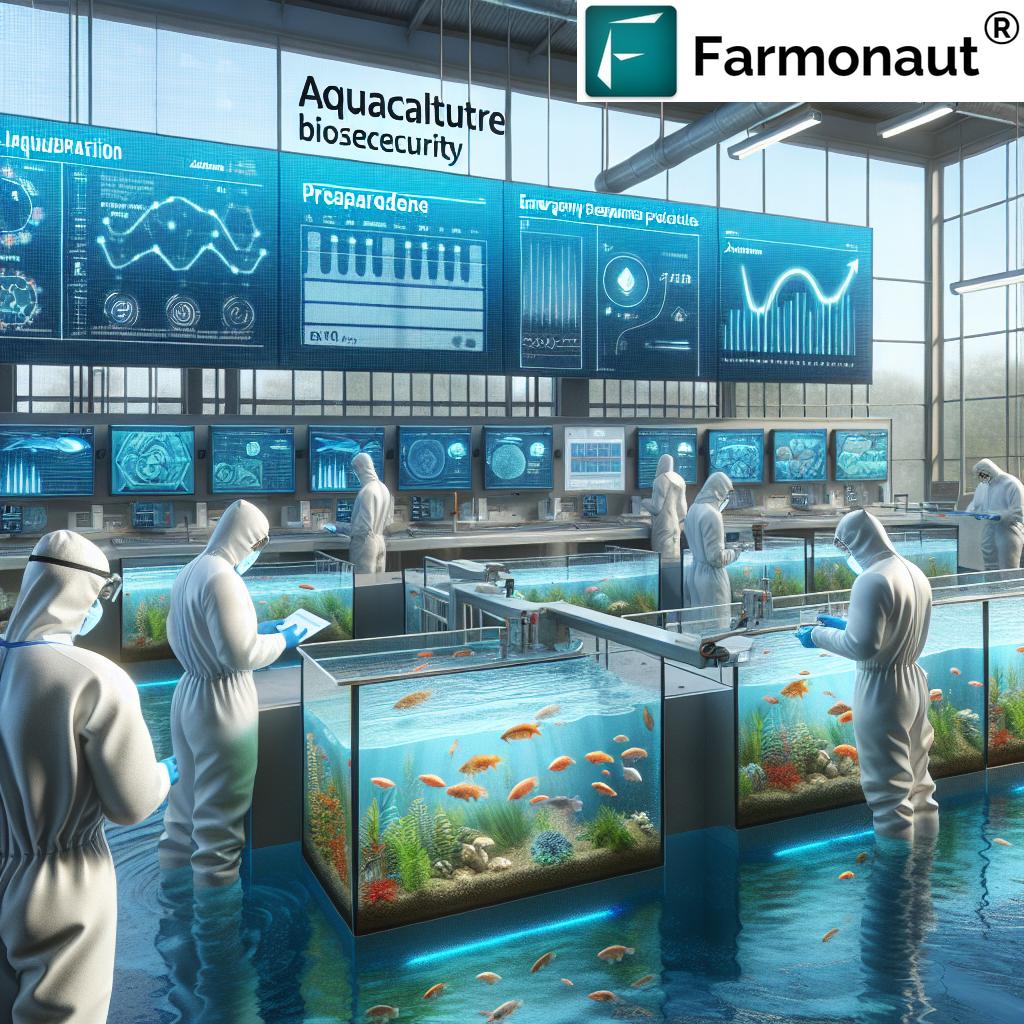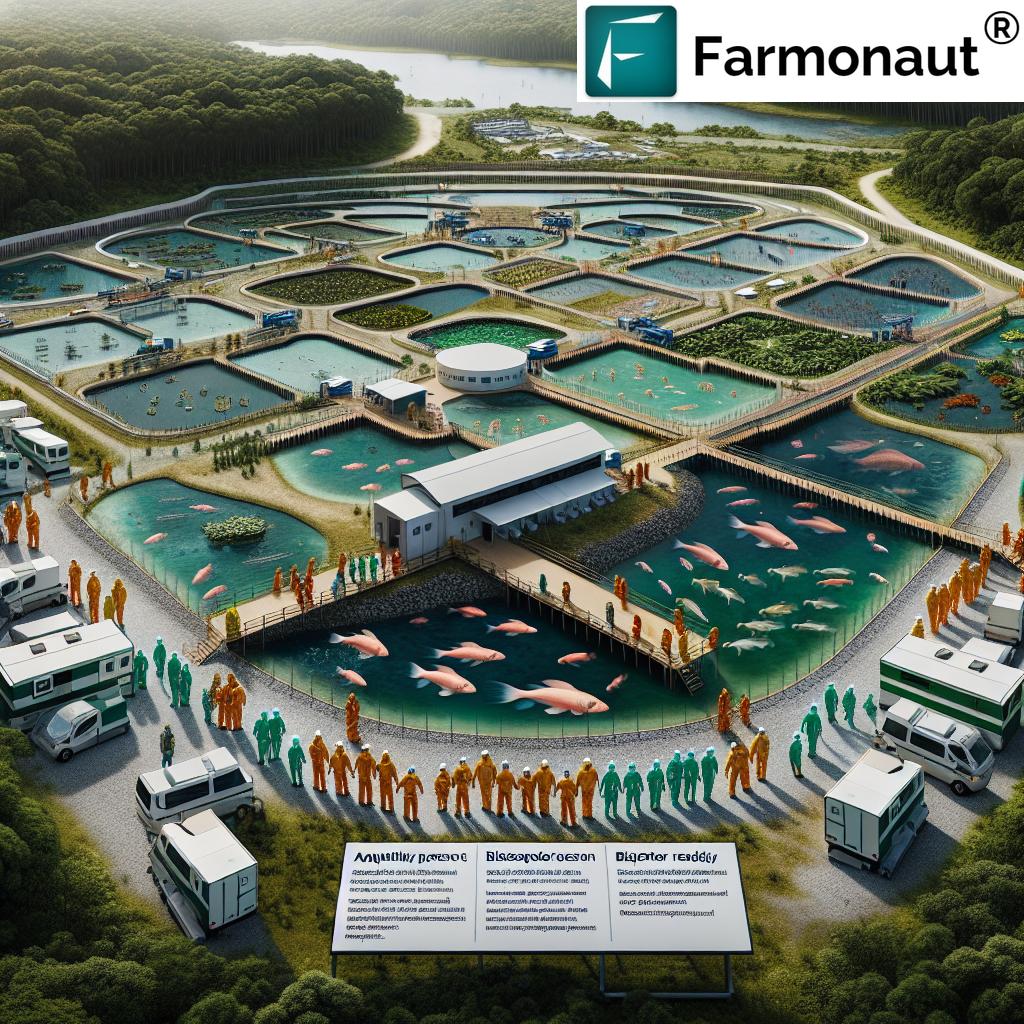Farmonaut’s Guide: Safeguarding Australia’s Aquaculture Through Advanced Biosecurity and Emergency Response Strategies

“Australia’s AQUAVETPLAN coordinates responses to over 20 high-priority exotic aquatic diseases, safeguarding the nation’s aquaculture industry.”
Welcome to Farmonaut’s comprehensive guide on safeguarding Australia’s aquaculture through advanced biosecurity and emergency response strategies. As leaders in precision agriculture technology, we recognize the critical importance of aquatic animal disease management and biosecurity in aquaculture for ensuring sustainable fisheries and food security. In this blog post, we’ll explore Australia’s robust emergency response framework for aquatic animal health, highlighting key components such as the AQUAVETPLAN and its pivotal role in preparedness and control measures.
Our journey will take us through the intricacies of emergency response in fisheries, the coordination efforts of the Aquatic Consultative Committee on Emergency Animal Disease, and the essential Aquatic Animal Diseases Identification Field Guide. We’ll delve into contingency planning, simulation exercises, and risk mitigation strategies for high-priority exotic aquatic diseases that threaten Australia’s aquaculture industry.
The Importance of Aquatic Biosecurity in Australia
Australia’s vast coastline and diverse aquatic ecosystems make it a prime location for aquaculture. However, this also presents unique challenges in terms of biosecurity in aquaculture and disease prevention in fish farming. The Australian government, in collaboration with industry stakeholders, has developed a comprehensive framework to address these challenges and protect the nation’s aquatic resources.
- Safeguarding economic interests in fisheries and aquaculture
- Protecting native aquatic species and ecosystems
- Ensuring food security and sustainable seafood production
- Maintaining Australia’s reputation as a producer of high-quality aquatic products
At Farmonaut, we understand the significance of these efforts and how they align with our mission to make precision agriculture accessible and affordable. While our primary focus is on land-based agriculture, many of the principles and technologies we use can be adapted to support aquaculture risk mitigation and management.
AQUAVETPLAN: Australia’s Blueprint for Aquatic Animal Health Emergencies
The Australian Aquatic Veterinary Emergency Plan (AQUAVETPLAN) is the cornerstone of Australia’s preparedness for aquatic animal disease outbreaks. This comprehensive set of manuals outlines the national approach to managing aquatic animal disease emergencies.
Key Components of AQUAVETPLAN:
- Disease Strategy Manuals: Detailed guidelines for specific high-priority aquatic diseases
- Operational Procedures Manuals: Protocols for decontamination, disposal, and other critical activities
- Enterprise Manuals: Tailored strategies for different types of aquaculture facilities
- Management Manuals: Overarching principles for disease control and eradication
AQUAVETPLAN is designed to ensure a rapid and effective response to aquatic animal disease outbreaks, minimizing the impact on Australia’s aquaculture industry and wild fisheries. It’s a living document, regularly updated to reflect the latest scientific knowledge and best practices in aquatic animal disease management.
The Aquatic Consultative Committee on Emergency Animal Disease (AqCCEAD)
Coordinating a national response to potential aquatic animal disease outbreaks requires a dedicated and expert body. This is where the Aquatic Consultative Committee on Emergency Animal Disease (AqCCEAD) comes into play. The AqCCEAD is a crucial component of Australia’s emergency response in fisheries and aquaculture.
Roles and Responsibilities of AqCCEAD:
- Providing technical advice during disease outbreaks
- Coordinating national responses to aquatic animal health emergencies
- Facilitating communication between government agencies and industry stakeholders
- Recommending control and eradication strategies
The AqCCEAD brings together experts from various fields, including veterinary science, aquaculture, and public health, to ensure a comprehensive and well-informed approach to managing aquatic animal disease outbreaks. This collaborative effort is essential for maintaining the health and sustainability of Australia’s aquaculture industry.
Explore Farmonaut’s API for advanced agricultural insights
The Aquatic Animal Diseases Identification Field Guide: A Critical Tool for Rapid Response
“The Aquatic Animal Diseases Identification Field Guide covers more than 50 critical diseases, aiding rapid diagnosis in emergency situations.”
Rapid identification of aquatic animal diseases is crucial for effective emergency response in fisheries and aquaculture. The Aquatic Animal Diseases Identification Field Guide is an invaluable resource for fish farmers, veterinarians, and biosecurity officers on the front lines of disease prevention in fish farming.
Features of the Field Guide:
- Detailed descriptions and images of over 50 critical aquatic diseases
- Easy-to-use format for quick reference in the field
- Information on disease transmission, clinical signs, and diagnostic methods
- Guidance on initial response and reporting procedures
This guide plays a crucial role in Australia’s early warning system for aquatic animal diseases, enabling rapid detection and response to potential outbreaks. By empowering those working directly with aquatic animals to identify signs of disease quickly, the guide contributes significantly to the overall effectiveness of Australia’s aquatic animal health monitoring efforts.

Contingency Planning and Simulation Exercises: Preparing for the Unexpected
Effective fisheries disaster preparedness requires more than just reactive measures. Australia’s approach to aquaculture risk mitigation includes proactive contingency planning and regular simulation exercises. These activities ensure that all stakeholders are prepared to respond swiftly and effectively in the event of an aquatic animal disease outbreak.
Key Elements of Contingency Planning:
- Identification of potential disease threats and their likely impacts
- Development of detailed response protocols for various scenarios
- Allocation of resources and designation of responsibilities
- Establishment of communication channels and decision-making processes
Simulation exercises play a crucial role in testing and refining these contingency plans. They provide valuable opportunities for stakeholders to practice their roles, identify potential weaknesses in the response system, and improve coordination between different agencies and industry partners.
Risk Mitigation Strategies for High-Priority Exotic Aquatic Diseases
Australia’s approach to aquaculture risk mitigation focuses on preventing the introduction and spread of high-priority exotic aquatic diseases. These diseases pose significant threats to both farmed and wild aquatic populations, with potential for severe economic and ecological impacts.
Key Risk Mitigation Strategies:
- Border Control: Strict quarantine measures for imported aquatic animals and products
- Surveillance Programs: Regular monitoring of both farmed and wild populations for signs of disease
- Biosecurity Protocols: Implementation of rigorous on-farm biosecurity measures
- Research and Development: Ongoing studies to improve disease detection and management techniques
These strategies are designed to work in concert, creating multiple layers of protection against the introduction and spread of exotic aquatic diseases. By focusing on prevention and early detection, Australia aims to minimize the need for large-scale emergency responses.
Access Farmonaut’s API Developer Docs for integration guidance
Collaborative Approach: Government and Industry Partnerships
Effective biosecurity in aquaculture requires a collaborative approach between government agencies and industry stakeholders. In Australia, this partnership is exemplified through the development of on-farm biosecurity plans and policies for live aquatic animal translocation.
Key Areas of Collaboration:
- Development and implementation of industry-specific biosecurity guidelines
- Joint funding of research initiatives for disease prevention and control
- Regular consultation on policy development and regulatory frameworks
- Coordinated response efforts during disease outbreaks
This collaborative approach ensures that biosecurity measures are practical, effective, and tailored to the specific needs of different aquaculture sectors. It also fosters a shared responsibility for maintaining the health and sustainability of Australia’s aquatic ecosystems.
Sustainable Aquaculture Practices: Balancing Production and Protection
Sustainable aquaculture practices are essential for long-term industry viability and environmental protection. Australia’s approach to aquaculture management emphasizes the importance of balancing productive output with ecological responsibility.
Key Aspects of Sustainable Aquaculture:
- Implementation of ecosystem-based management approaches
- Development of environmentally friendly feed and waste management systems
- Promotion of integrated multi-trophic aquaculture systems
- Adoption of technologies for improved water quality monitoring and management
These practices not only contribute to the overall health of aquatic ecosystems but also enhance the resilience of aquaculture operations to disease outbreaks and other environmental challenges. At Farmonaut, we recognize the parallels between sustainable land-based agriculture and aquaculture, and our precision agriculture tools can be adapted to support sustainable aquaculture management.
Aquatic Pest Control: An Integral Part of Biosecurity
Aquatic pest control is a critical component of Australia’s comprehensive approach to biosecurity in aquaculture. Pests can cause significant damage to aquaculture operations and natural ecosystems, often serving as vectors for disease transmission.
Key Strategies for Aquatic Pest Control:
- Regular monitoring and early detection programs
- Development of integrated pest management strategies
- Research into biological control methods
- Implementation of strict quarantine measures for equipment and stock transfers
Effective pest control contributes to the overall health of aquatic ecosystems and helps prevent the establishment of invasive species that could disrupt native biodiversity. It’s an essential aspect of maintaining the integrity and productivity of Australia’s aquaculture industry.
The Role of Technology in Aquatic Animal Health Monitoring
Advancements in technology play a crucial role in enhancing aquatic animal health monitoring and disease prevention efforts. From satellite imaging to AI-powered diagnostic tools, innovative technologies are revolutionizing the way we approach aquaculture management and biosecurity.
Technological Innovations in Aquaculture:
- Remote sensing for water quality monitoring
- AI-powered disease detection systems
- Blockchain technology for improved traceability in aquaculture supply chains
- IoT devices for real-time environmental monitoring in aquaculture facilities
At Farmonaut, we’re at the forefront of developing precision agriculture technologies that can be adapted for use in aquaculture settings. Our satellite-based monitoring systems and AI advisory tools have the potential to significantly enhance aquatic animal disease management and overall farm productivity.
Climate Change and Its Impact on Aquatic Animal Health
The effects of climate change pose significant challenges to aquatic animal health monitoring and management. Rising water temperatures, changing ocean chemistry, and increased frequency of extreme weather events all have the potential to impact disease dynamics in aquatic ecosystems.
Climate-Related Challenges for Aquaculture:
- Increased prevalence of certain pathogens due to warming waters
- Altered distribution of aquatic species and their associated diseases
- Increased stress on aquatic animals, potentially reducing disease resistance
- Changes in water quality affecting disease transmission and host susceptibility
Addressing these challenges requires adaptive management strategies and ongoing research into the complex interactions between climate change, aquatic ecosystems, and disease dynamics. Australia’s approach to aquaculture risk mitigation increasingly incorporates climate change considerations into biosecurity planning and disease management strategies.
Farmonaut’s Contribution to Aquaculture Management
While Farmonaut’s primary focus is on land-based agriculture, many of our technologies and approaches have potential applications in aquaculture management. Our expertise in satellite-based monitoring, AI-driven analytics, and precision agriculture can be adapted to support sustainable aquaculture practices and enhance biosecurity efforts.
Potential Applications of Farmonaut’s Technology in Aquaculture:
- Satellite monitoring of coastal and inland aquaculture sites
- AI-powered analysis of water quality and environmental factors
- Predictive modeling for disease outbreaks based on environmental data
- Integration of blockchain technology for improved traceability in aquaculture supply chains
As we continue to innovate in the field of precision agriculture, we’re excited about the potential to contribute to the advancement of aquaculture management and biosecurity practices in Australia and beyond.
Conclusion: A Holistic Approach to Aquaculture Biosecurity
Australia’s comprehensive approach to aquatic animal disease management and biosecurity in aquaculture serves as a model for sustainable fisheries management worldwide. By combining robust regulatory frameworks, collaborative partnerships, cutting-edge technology, and a commitment to sustainability, Australia is well-positioned to address the challenges facing its aquaculture industry.
As we’ve explored in this guide, effective biosecurity in aquaculture requires a multi-faceted approach that encompasses:
- Comprehensive emergency response frameworks like AQUAVETPLAN
- Coordinated efforts through bodies such as the AqCCEAD
- Proactive risk mitigation strategies and contingency planning
- Sustainable aquaculture practices that balance production with environmental protection
- Innovative technologies for monitoring and disease prevention
- Adaptive strategies to address the challenges posed by climate change
At Farmonaut, we’re committed to supporting sustainable agricultural practices through our precision agriculture technologies. While our primary focus is on land-based farming, we recognize the parallels between terrestrial and aquatic agriculture and the potential for cross-sector innovation. As the aquaculture industry continues to evolve, we look forward to exploring ways in which our technologies can contribute to enhanced biosecurity, sustainability, and productivity in this vital sector.
By working together – government agencies, industry stakeholders, technology providers, and researchers – we can ensure the long-term health and sustainability of Australia’s aquaculture industry, safeguarding this valuable resource for future generations.
Australian Aquaculture Biosecurity Framework Comparison
| Strategy/Component | AQUAVETPLAN | Aquatic Consultative Committee | On-Farm Biosecurity Plans |
|---|---|---|---|
| Primary Focus | National disease response framework | Coordination of emergency responses | Individual farm-level biosecurity |
| Key Stakeholders | Government agencies, industry bodies | Experts from various fields, government representatives | Farm owners, local authorities |
| Implementation Timeline | Ongoing, with regular updates | Activated during emergencies | Continuous implementation |
| Risk Mitigation Measures | Detailed disease strategies, operational procedures | Rapid response coordination, expert advice | Preventive measures, daily monitoring |
| Effectiveness Rating (1-5 scale) | 5 | 4 | 4 |
FAQs: Aquaculture Biosecurity and Emergency Response in Australia
- What is AQUAVETPLAN?
AQUAVETPLAN is the Australian Aquatic Veterinary Emergency Plan, a series of manuals outlining Australia’s approach to national disease preparedness and response strategies in aquatic animal health emergencies. - How does the Aquatic Consultative Committee on Emergency Animal Disease (AqCCEAD) function?
The AqCCEAD coordinates national responses to aquatic animal health emergencies, providing technical advice and facilitating communication between government agencies and industry stakeholders. - What role does the Aquatic Animal Diseases Identification Field Guide play in biosecurity?
This guide is a critical tool for rapid disease identification in the field, covering over 50 aquatic diseases and aiding in quick diagnosis during emergency situations. - How does Australia approach aquatic pest control?
Australia implements a comprehensive approach including regular monitoring, integrated pest management strategies, research into biological control methods, and strict quarantine measures. - What are some sustainable aquaculture practices promoted in Australia?
Sustainable practices include ecosystem-based management, environmentally friendly feed and waste systems, integrated multi-trophic aquaculture, and advanced water quality monitoring technologies.
















